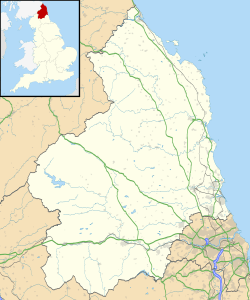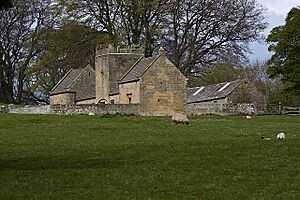Bitchfield Tower facts for kids
Quick facts for kids Bitchfield Tower |
|
|---|---|
| Northumberland, England, UK | |
|
Location in Northumberland
|
|
| Coordinates | 55°05′20″N 1°51′25″W / 55.089°N 1.857°W |
Bitchfield Tower, also known as West Bitchfield Tower, is a cool old building from the 1400s. It's a type of small castle called a pele tower. You can find it near Belsay in Northumberland, England. This tower is so important that it's a Grade I listed building, which means it's one of the most special historic buildings in the country!
Contents
Discovering Bitchfield Tower
Bitchfield Tower is a medieval (that means from the Middle Ages) building. It's a pele tower, which was a strong, small tower built to protect people from raids, especially along the border between England and Scotland. This tower has three floors and a battlement at the top, which is a fancy wall with gaps for defense.
Who Built This Tower?
The Middleton family built Bitchfield Tower in the 1400s. They owned it for a while before selling it to the Harbottle family in 1502.
The Fenwick Family's Time
A lady named Marjorie Harbottle, who was the heir to the Harbottle family's property, married Sir John Fenwick. In 1529, they passed the tower to their second son, Roger Fenwick. Later, in 1622, Robert Fenwick built a new manor house right next to the tower. You can still see a stone with 'RF 1622 JF' carved into it, showing when it was built.
Changing Hands Over Centuries
The Fenwick family sold the estate in 1630 to Edward Grey. After that, the tower changed owners several times. In 1680, Sir James Clavering bought it. Then, in 1802, the Clavering family sold it to Sir Charles Monck.
Bringing the Tower Back to Life
By 1930, Bitchfield Tower was in ruins, meaning it was falling apart. But thankfully, it has been carefully restored since then! This means people worked hard to fix it up and make it strong again. An east wing was added to the tower in 1935 by people like Caroë and Lord Gort. The tower has been officially listed as a Grade I building since August 27, 1952, recognizing its historical importance.



